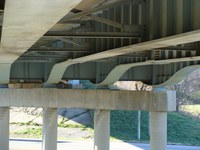Reliability Based Bridge Inspection
Currently, most bridges in the United States are inspected at a fixed calendar interval of 24 months, without regard to the condition of the bridge. Newer bridges with little or no damage are inspected with the same frequency as older, more deteriorated bridges thus creating inefficiency in the allocation of inspection resources. The objective of this project was to develop risk-based inspection practices to improve the safety and reliability of bridges and optimize resources for bridge inspection in Indiana. The proposed methodology asked: What can go wrong? How likely is it? What are the consequences if it happens? Key tasks involved developing a Risk Assessment Panel, evaluating state-owned Indiana highway bridges using the risk-based criteria, developing families of bridges, and creating a short and long-term implementation plan.
Sponsor: Indiana Department of Transportation
Faculty Investigator: Robert J. Connor
Graduate Student: Becky Reising
FINDINGS
The Indiana Department of Transportation’s Risk Assessment Panel, developed during this research, incorporated reliability theory and expert elicitation to rationally determine bridge inspection needs. The panel consisted of INDOT officials, academic experts, and consultants. Assessments were made based on the likelihood and consequence of failure for specific bridge components. The likelihood of failure was determined through attributes based on design, loading, and condition characteristics while the consequence of failure was based on expected structural capacity, public safety, and serviceability. By combining the expressions of likelihood and consequence for each component, an optimum inspection interval for the entire bridge could be determined through the use of risk matrices.
Families of bridges were created to recognize the similarity of design, condition, and loading attributes in the risk process. If implemented, at least 20% of Indiana bridges could immediately have an extended interval of 48 months. Results of the case studies conducted during the research indicated that the risk analysis procedures provided suitable inspection intervals ranging from 12 to 72 months for Indiana bridges.
An evaluation of 36 bridges in the Indiana inventory was conducted, and 21 of those 36 bridges (60%) had extended inspection intervals at some point during the lifetime of the bridge. Historical inspection data was used to evaluate the methodology, and there were no cases where a serious progression of damage would have been missed as a result of an extended inspection interval.
An implementation strategy to provide a technical foundation for the methodology and develop community support was proposed to ease the transition period. The implementation of the risk-based inspection procedures may be a challenge in the short-term, but has outweighing payoffs in terms of increased safety, increased reliability, and increased efficiency of inspections in the long term.
Indiana can immediately benefit from the implementation of risk-based inspection practices. Based upon families of bridges, 20% of the Indiana inventory could have extended intervals of either 48 or 72 months. Approximately 1200 state-owned bridges could be safely moved to a 48 month inspection interval with NO adverse effect on safety or serviceability. The FHWA currently permits a 48 month policy for bridge inspection intervals. Of the 36 bridges analyzed during the back-casting process, it was found that for 21 bridges, extended intervals were possible, which is approximately 60% of the 36. This suggests that for bridges not falling into a family, extended risk-based intervals are also possible without compromising safety or serviceability.
The proposed risk-based methodology could transform traditional calendar-based approaches and optimize the use of bridge inspection resources as well as improve reliability and safety of highway bridges in Indiana. With additional study, the proposed risk-based approach could also transform bridge inspection practices in the United States.
The final report can be found here:

